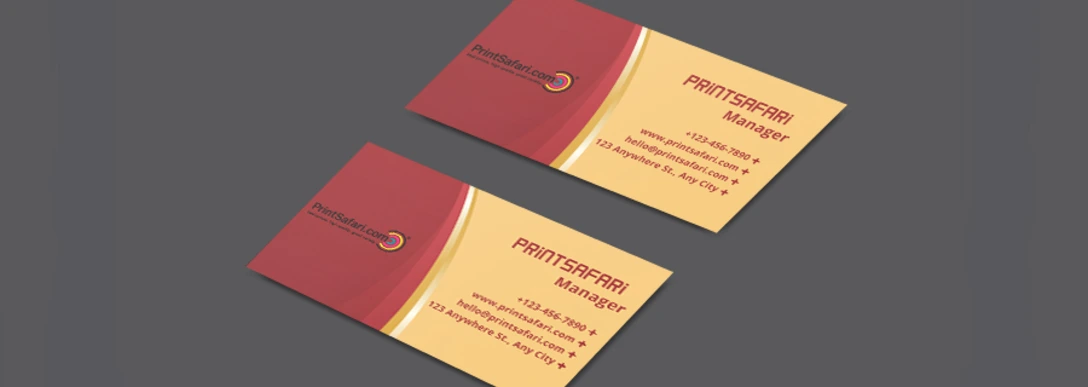How to Design the Ultimate Business Card
Design business cards may seem like a small item, but it’s a powerful tool in the world of networking and professional branding. Despite the rise of digital communication and social media, ordering business cards online has become an easy and efficient way to design and print high-quality cards. Business cards remain an essential way to make a memorable first impression.
 In today’s fast-paced digital world, designing the ultimate business card can set you apart from the competition. Whether you’re attending a networking event and handing out your business card in person, your card speaks volumes about you and your business. This guide will walk you through how to design the perfect business card, with a special focus on the convenience and benefits of ordering business cards online, so you can create a card that’s not only visually striking but also functional and aligned with your professional image.
In today’s fast-paced digital world, designing the ultimate business card can set you apart from the competition. Whether you’re attending a networking event and handing out your business card in person, your card speaks volumes about you and your business. This guide will walk you through how to design the perfect business card, with a special focus on the convenience and benefits of ordering business cards online, so you can create a card that’s not only visually striking but also functional and aligned with your professional image.
Choosing the Right Business Card Design
When it comes to creating a business card, the design is everything. It's the first impression you'll make on potential clients or contacts. Choosing the right design for your business card involves considering various factors to ensure it represents you and your brand effectively. Here are the key elements to keep in mind:
- Shape: Traditional rectangular cards are common, but exploring unique shapes can make your card stand out. Consider rounded corners, square shapes, or even custom die-cut designs.
- Color Scheme: Choose colors that reflect your brand identity. Bright colors may indicate creativity, while muted tones suggest professionalism and elegance.
- Font Style: The typeface you choose says a lot about your business. Use modern, clean fonts for a contemporary feel or classic serif fonts for a more traditional look.
- Logo Placement: Ensure your logo is prominently displayed. It should be one of the first things noticed on the card, representing your brand’s identity clearly.
- Layout: Consider how your information is arranged. A clean and organized layout ensures the card is easy to read and visually appealing. Keep it balanced and avoid cluttering it with too much information.
- Materials: Don’t forget the texture of your card. The paper type and finish can affect how professional and high-quality your card feels.
Incorporating these design elements thoughtfully will ensure that your business card stands out and leaves a lasting impression.
Key Elements Every Business Card Should Include
Designing a business card is not just about aesthetics, it’s also about ensuring that it provides all the necessary information to make a strong impression. A business card should act as a compact representation of you and your business. Here are the key elements that every business card should include:
- Name: Your name is the most important piece of information on your card. Make sure it’s easy to read and stands out.
- Job Title: Clearly state your job title so people know what role you hold within your organization.
- Company Name and Logo: Your company’s name and logo should be clearly visible, reinforcing your brand identity.
- Contact Information: Include your phone number, email address, and website URL. Make it easy for people to reach out to you.
- Social Media Links: If relevant to your business, include links to your professional social media profiles (LinkedIn, Instagram, etc.).
- Physical Address: If your business has a physical location, include your office address. For digital businesses, this might not be necessary.
- Tagline or Services: A short, catchy tagline or a brief mention of your services can help make your card memorable.
These essential elements ensure that your business card not only looks good but also communicates everything the recipient needs to know in a clear and professional manner.
Comparison Table: Key Business Card Elements
| Element | Importance | Notes |
| Name | High | Make sure your name is prominently displayed and easy to read. |
| Job Title | High | Clarify your role to give context to your name and business. |
| Company Name & Logo | High | Ensure your logo is clear and your company name is easily visible. |
| Contact Information | High | Include phone number, email, and website for easy follow-up. |
| Social Media Links | Medium | Useful for networking, but only if relevant to your business. |
| Physical Address | Medium | Include if applicable (mainly for businesses with a physical location). |
| Tagline/Services | Medium | A catchy phrase or services offered can make your card memorable. |
By thoughtfully including these elements, your business card will not only look polished but also function as an effective networking tool, allowing people to easily connect with you.
Designing for Impact: Typography, Colors, and Graphics
When designing a business card, the way you use typography, colors, and graphics can make all the difference. These elements not only contribute to the visual appeal but also influence how your card communicates your brand identity. Let's explore each of these components and how they can elevate your design.

Typography: Setting the Tone for Your Brand
The typography on your business card plays a crucial role in how your brand is perceived. The choice of fonts should reflect your business’s personality—whether it’s modern and bold or traditional and refined. It’s important to select fonts that are readable, even at smaller sizes, so that all the information on your card is easy to read. Here are some general guidelines:
- Font Style: Choose a font that matches your brand’s tone. For example, a creative agency may opt for a unique, playful font, while a law firm may choose a more serious, professional typeface.
- Font Size: Make sure the font size is large enough for easy readability. The key information, like your name and job title, should stand out and be legible without straining the eyes.
- Font Pairing: If you choose to use more than one font, ensure that they complement each other. Avoid using too many different fonts, as it can make your card feel cluttered.
Colors: Creating Visual Impact
Color is one of the most powerful design elements, as it triggers emotions and sets the mood for your card. The color scheme should align with your brand’s personality and convey the message you want to send. Here are a few color tips:
- Brand Colors: Use colors that are part of your brand’s color palette to maintain consistency across all your marketing materials. This helps reinforce your brand identity.
- Contrast: Ensure there is enough contrast between the text and background to make the card easy to read. Dark text on a light background or vice versa works well.
- Accent Colors: Use accent colors to draw attention to specific elements, like your name or logo. But be careful not to overdo it—too many contrasting colors can be overwhelming.
Graphics: Adding Visual Interest
Graphics such as logos, icons, or images can make your business card stand out and give it personality. Graphics should complement the text and design, not overwhelm it. Consider using your company logo prominently, as well as any other relevant visuals that align with your brand's message.
- Logo: Your logo is the cornerstone of your business card design. It should be clearly visible and placed in a position where it draws attention, such as the top corner or center of the card.
- Iconography: If your business involves specific services or products, using small icons can help illustrate your offerings without crowding the design.
- Visual Balance: Strive for balance between text and images. Overcrowding a card with too many graphics can distract from the important information.
By carefully selecting typography, colors, and graphics, you can create a business card that not only looks great but also communicates your brand's values and message effectively. It’s essential to strike the right balance between creativity and professionalism to ensure that your card leaves a lasting impression.
For those looking to bring their business card design to life, visit our business card printing service to explore various design options and start creating your perfect business card today.
Finalizing Your Business Card: From Design to Print
Once your business card design is complete, it’s time to focus on the production process. The final touches are crucial to turning your digital design into a tangible card that leaves a lasting impression.
Start by choosing the right printing method. The most common is offset printing, ideal for accurate color reproduction and large runs. If you’re looking for something unique, letterpress printing creates a deep, tactile impression, giving your card a premium feel.

Next, consider your paper stock. A thicker cardstock gives your card a more professional and durable look. For a luxury finish, options like velvet or soft-touch paper add sophistication. The texture of your paper will influence how recipients perceive your brand.
When it comes to the finish, decide between a glossy or matte coating. A glossy finish enhances colors and makes the design pop, while matte gives a more refined, understated look. Spot gloss can highlight specific elements, such as your logo, for added emphasis.
Before sending your design to print, ensure your file is in the correct format (PDF) with a resolution of 300 DPI and includes bleed areas. A quick final review for typos and alignment ensures your cards print perfectly.
Frequently Asked Questions
What should I include on my business card?
Your business card should include your name, job title, company name, phone number, email address, and website. You may also want to include social media profiles like LinkedIn or Instagram if relevant. If applicable, adding your office address or location can be helpful for face-to-face interactions.
What is the ideal size for a business card?
The most common size for business cards is 3.5 x 2 inches in North America and 2.17 × 3.35 inches in Europe. While this is standard, custom shapes and sizes are increasingly popular to make your card more unique. If you decide on a custom size, make sure it fits in wallets or business card holders for practical use.
How do I choose the right paper for my business card?
Choosing the right paper for your business card is essential to reflect your brand’s image. A thicker cardstock makes the card feel premium and durable, while papers with unique textures like linen or cotton can give it a more sophisticated or eco-friendly look. If you’re looking for something more luxurious, consider using specialty finishes such as soft-touch or velvet papers to create a memorable impression.
How can I make my business card stand out from others?
To make your business card stand out, focus on creative design and unique finishes. Use bold colors, custom shapes, and fonts that align with your brand. You can also consider special printing techniques such as embossing, foil stamping, or spot UV coating to give your card a premium feel. By blending creativity with practicality, your business card will leave a lasting impression that reflects your professional identity.






